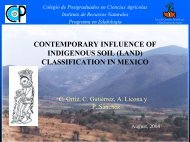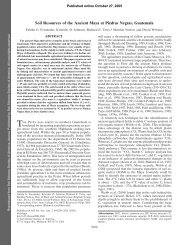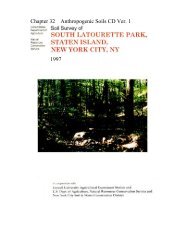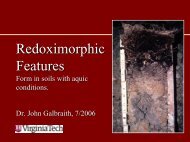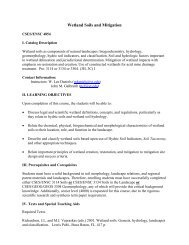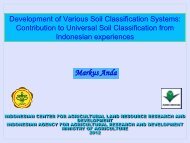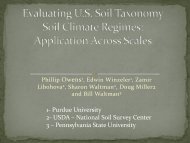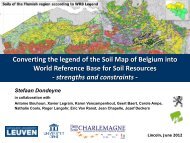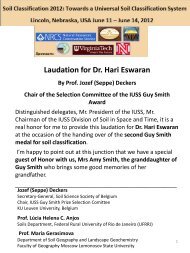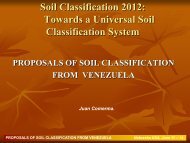Nebraska Soils Field Trip - Virginia Tech
Nebraska Soils Field Trip - Virginia Tech
Nebraska Soils Field Trip - Virginia Tech
You also want an ePaper? Increase the reach of your titles
YUMPU automatically turns print PDFs into web optimized ePapers that Google loves.
4th IUSS Soil Classification Conference <strong>Field</strong> Tour Guidebook<br />
The Cretaceous-age Dakota Sandstone is at a shallow or moderate depth in the northern half of this area.<br />
It is tapped by many domestic and livestock wells. A few irrigation wells tap this aquifer. In areas where<br />
more shallow aquifers do not occur, a number of communities obtain their public supplies from this<br />
aquifer. Locally, the base of the Dakota Sandstone has beds of gravel from which moderately large yields<br />
can be obtained. The median level of total dissolved solids in the aquifer in Iowa and <strong>Nebraska</strong> is 824 and<br />
840 parts per million (milligrams per liter), respectively, and the water is very hard.<br />
The Jordan aquifer is the most extensively used aquifer in Iowa. It consists of Ordovician-Cambrian<br />
sandstone and dolomite beds. Its water has a median level of total dissolved solids that exceeds 800<br />
parts per million (milligrams per liter) and may contain levels of radium that exceed the national standards<br />
for drinking water. Some communities in the part of this area in Iowa depend on this aquifer for public<br />
supplies, even though the wells are very deep. Paleozoic units serve as aquifers in the parts of this area<br />
in southeastern <strong>Nebraska</strong> and northwestern Missouri. Water from these aquifers has a median level of<br />
total dissolved solids of 1,300 parts per million (milligrams per liter) in <strong>Nebraska</strong>. Many farmers and<br />
communities in Missouri have abandoned wells in these units because of high levels of dissolved salts.<br />
<strong>Soils</strong><br />
The dominant soil orders in this MLRA are Mollisols and, to a lesser extent, Alfisols and Entisols. The<br />
soils in the area dominantly have a mesic soil temperature regime, an aquic or udic soil moisture regime,<br />
and mixed mineralogy. They generally are very deep, well drained or moderately well drained, and silty or<br />
loamy. Well drained and moderately well drained, gently sloping to strongly sloping Hapludolls (Marshall<br />
and Monona series) formed on loess-mantled uplands. Well drained, strongly sloping Alfisols (Knox<br />
series) formed in loess. Well drained, strongly sloping Udorthents on side slopes (Steinauer series) and<br />
Argiudolls (Shelby series) formed in clay loam glacial till. Somewhat excessively drained and well drained,<br />
strongly sloping to very steep Udorthents (Hamburg and Ida series) on uplands formed in thick layers of<br />
loess bordering the Missouri River. Well drained and moderately well drained Udifluvents (Haynie and<br />
McPaul series) and Hapludolls (Keg, Kennebec, Napier, and Salix series), somewhat poorly drained or<br />
poorly drained Fluvaquents (Onawa and Albaton series), and poorly drained or very poorly drained<br />
Haplaquolls (Colo, Luton, and Wabash series) formed in alluvium on bottom land.<br />
Biological Resources<br />
Prairies in this area support tall grasses on moist soils and xeric short grasses on uplands. Within the<br />
prairies, grama, muhly, lovegrass, and wheatgrass commonly grow beside the more familiar little<br />
bluestem, big bluestem, Indiangrass, and wildrye. The most common forbs are eared milkweed, Missouri<br />
milkvetch, prairie tea, western prairie fringed orchid, yucca, Baldwin ironweed, painted cup, pale gentian,<br />
silky aster, and skeletonweed (in the loess hills).<br />
The wooded areas on uplands commonly support red oak, white oak, hackberry, shagbark hickory, and<br />
bitternut hickory. The wooded areas on bottomland commonly support mulberry, sycamore, cottonwood,<br />
willow, elms, green ash, silver maple, and American elder.<br />
The wildlife species in the prairies include barn and longeared owls; broad-winged hawk; Leonard’s,<br />
Pawnee, Ottoe, and dusted skippers; wild indigo and sleepy dusky wings; and zebra swallowtail, Great<br />
Plains toad, plains leopard frog, plains spadefoot, massasauga rattlesnake, prairie skink, ornate box<br />
turtle, six lined racerunner, bobcat, black-tailed jackrabbit, plains pocket mouse, and least shrew. The<br />
wildlife species in the wooded areas include blue grosbeak, great crested flycatcher, western<br />
meadowlark, western fox snake, western worm snake, and Woodhouse’s toad. This area has 47<br />
threatened or endangered species or species of special concern, including piping plover, blacknose and<br />
Topeka shiners, pallid sturgeon, least tern, small white lady’s slipper, bog buckbean, yellow monkey<br />
flower, and spring ladies-tresses.<br />
Land Use<br />
Following are the various kinds of land use in this MLRA:<br />
Cropland—private, 69%<br />
25





